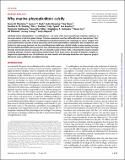Why marine phytoplankton calcify
Author(s)
Monteiro, F. M.; Bach, L. T.; Brownlee, C.; Bown, P.; Rickaby, R. E. M.; Poulton, A. J.; Tyrrell, T.; Beaufort, L.; Gibbs, S.; Gutowska, M. A.; Lee, R.; Riebesell, U.; Young, J.; Ridgwell, A.; Dutkiewicz, Stephanie; ... Show more Show less
Downloade1501822.full.pdf (951.9Kb)
PUBLISHER_POLICY
Publisher Policy
Article is made available in accordance with the publisher's policy and may be subject to US copyright law. Please refer to the publisher's site for terms of use.
Terms of use
Metadata
Show full item recordAbstract
Calcifying marine phytoplankton—coccolithophores— are some of the most successful yet enigmatic organisms in the ocean and are at risk from global change. To better understand how they will be affected, we need to know “why” coccolithophores calcify. We review coccolithophorid evolutionary history and cell biology as well as insights from recent experiments to provide a critical assessment of the costs and benefits of calcification. We conclude that calcification has high energy demands and that coccolithophores might have calcified initially to reduce grazing pressure but that additional benefits such as protection from photodamage and viral/bacterial attack further explain their high diversity and broad spectrum ecology. The cost-benefit aspect of these traits is illustrated by novel ecosystem modeling, although conclusive observations remain limited. In the future ocean, the trade-off between changing ecological and physiological costs of calcification and their benefits will ultimately decide how this important group is affected by ocean acidification and global warming.
Date issued
2016-07Department
Massachusetts Institute of Technology. Center for Global Change Science; Massachusetts Institute of Technology. Department of Earth, Atmospheric, and Planetary SciencesJournal
Science Advances
Publisher
American Association for the Advancement of Science (AAAS)
Citation
Monteiro, F. M., L. T. Bach, C. Brownlee, P. Bown, R. E. M. Rickaby, A. J. Poulton, T. Tyrrell, et al. “Why Marine Phytoplankton Calcify.” Science Advances 2, no. 7 (July 13, 2016): e1501822–e1501822.
Version: Final published version
ISSN
2375-2548